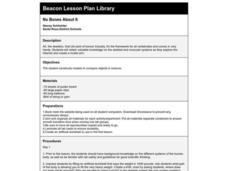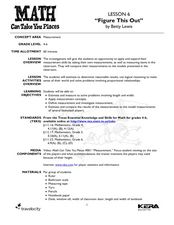Curated OER
Levers and Wedges in the Human Body
Young biologists identify parts of the body that serve as wedges (teeth and fingernails), and as levers (jaw, arms, and legs). The hands-on activities described here should be exciting for learners to perform, and should also lead to a...
NOAA
Biological Oceanographic Investigations – Call to Arms
How many simple machines does it take to make a robotic arm? An inquiry-based lesson explores that topic and challenges pupils to build a robotic arm that can stretch, turn, and more. A few questions help guide them in the right...
Curated OER
Call to Arms: Robotic Analogues for Human Structures
Investigate deep sea discovery through the emerging technology being built. In this physical science lesson, students analyze the different types of motion available in the human arm. Students research educational websites discussing...
Curated OER
Biomechanics of Joints
Students investigate range of motion in human joints and the mechanical devices they emulate. They construct a human arm model with three joints which emulate the wrist, elbow and shoulder.
Curated OER
Levers and Wedges in the Human Body
Students identify the various parts of the body that serve as wedges and levers, identifying the fulcrum for each body lever. They bite into carrots and apples to analyze how their jaws and teeth work, then complete three worksheets that...
DiscoverE
Human Suspension Bridge
When is it okay to be suspended in school? When you're part of a human suspension bridge! Learners first model tension and compression in pairs. Once complete, they get together as a class to model a suspension bridge.
Curated OER
Natural Born Robots: Body Builders
Students perform activities to explore how their arm works and what muscles are involved. They view animated comparisons of human and robotic arms. Students create a model of the human arm.
Curated OER
Call to Arms
Learners explore how scientists build robotic arms that move similar to humans. In this robot lesson, students examine how scientists make robots. Learners design and construct a mechanical arm that moves like a human arm. Students...
NASA
The Robotic Arm
Working as teams, class members try to rescue an astronaut using the shuttle arm on a TI-Nspire simulation. Teams must determine the different angle measures in order to reach the stranded astronaut.
Curated OER
Chapter 2: The Economizing Problem
It doesn't take a lecture on economics to convince teenagers that one's wants often exceed one's means, but this presentation will hopefully help them to understand the discrepancy. Using an example of pizza and robot arms, the slides...
Curated OER
The Human Body: A Life-Size Model On Paper
Students create a life-size paper model of the human body. They identify the major organs and state their fuction. They complete a quiz to end the lesson.
Rochester Institute of Technology
Biomechanical Joint
Discuss mechanical advantage and how the human body moves/works. Learners focus on bioengineering, working together to build a functioning mechanical arm. Additionally, they analyze an air muscle, discussing its appropriate use in humans.
Curated OER
When Is It O.K. to Replace Human Limbs With Technology?
Today's blog topic is robotic limb replacement for amputees. Upper graders read the related article and argument, then compose a blog response that addresses the questions provided. This is a great way to get kids thinking about ethics,...
Curated OER
No Bones About It
Students conduct Internet research on the different parts of the skeletal system. Then they create a model arm that demonstrates how muscle and bone work together to create movement.
Curated OER
MuscleMania
Students learn three different types of muscles. By building a model of the arm, they learn its basic anatomy and how muscles function in relationship to bones. They perform an experiment on the relationship between muscle size and...
Rochester Institute of Technology
Biomechanical Hand
In 1993, five biomedical engineers in Edinburgh, Scotland, created the first functional bionic arm. In the activity, learners explore the world of bioengineering through discussion and hands-on exploration. In groups, participants...
Curated OER
Figuratively Speaking
Students create 8 inch, or bigger, clay sculptures of the human form in this Art lesson introducing clay sculpting techniques. The works of artists studied in preparation include Henry Moore, Michelangelo, Degas, Rodin and John Quincy...
Gwinnett County Public Schools
Analysis of the Tuck Everlasting and The Birchbark House Text Exemplars
Looking to introduce some text-based questions into your ELA lessons? Practice the kinds of skills the Common Core demands with the seven text-based questions and the essay prompt provided here. Designed to be a three-day lesson, day one...
Read Works
How to Say “I Ruff You”
Who says you need a human to be your valentine on Valentine's Day? Give your dog-loving readers an inspiring perspective on how a sister givdes her brother a valentine from the family dog. They then answer 10 questions thatd involve...
Curated OER
Levers in the Body: They Are Not What You Might Think!
Young scholars investigate lever systems in the human body and compare arm anatomy to model. In this human levers lesson students graph and analyze their results.
Curated OER
Human Geometry Book
Learners investigate geometric shapes. In this geometry lesson, students read the book The Greedy Triangle and define the shapes mentioned in the book. Learners make the shapes by using their bodies.
Curated OER
Bones
Fifth graders observe real bones and models to learn about the structure and function of the skeletal system. For this skeletal system lesson, 5th graders manipulate objects and models of bones. They handle real bones and determine the...
Curated OER
Figure This Out
Students measure different parts of the human body. In this measurement lesson, students work in pairs to take measurements of human measurements which include: arm span, height, foot length, and wrist to longest finger. They also...

























